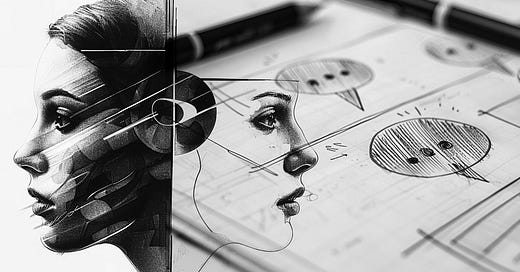In the dynamic world of AI and conversational interfaces, the question often arises among us, UX/UI designers: Will traditional UI remain essential as AI chatbots and voice interfaces become increasingly capable?
This inquiry isn't trivial, reflecting our concern for the future relevance of our craft. However, shifting the perspective to prioritise user needs unveils a different narrative. The key is understanding the nature of the task at hand and whether a chat interface simplifies the user's journey. When we place user needs at the forefront, the answer isn't as straightforward as it might seem. Navigating the evolving terrain of conversational AI, we're confronted with the limitations of traditional conversational chatbot UX/UI principles in managing complex user tasks. Here, a hybrid approach, merging chat and traditional UI elements, emerges as an innovative solution, promising enhanced efficiency and a more intuitive user experience.
Challenges of Conventional Chatbot Design in Complex User Tasks
Consider a user entangled in a complex application process through a standard chatbot interface. The traditional method of sequential questioning, though efficient for straightforward interactions, proves tedious and limiting in more complex scenarios. This linear approach can frustrate users, detracting from the overall experience. The free-text nature of chat interfaces can also lead to digressions, making it challenging for both users and AI to maintain focus.
Traditional UI's capability to visually represent progress and structure, offers a clearer path through complex tasks, a feat difficult to replicate in pure chat interfaces. Additionally, ensuring the accuracy of user inputs within a conversational interface is notably challenging, potentially slowing down the process and diminishing efficiency.
In financial services in particular, from a regulatory and customer obligations point of view, we must ensure customers understand the outcomes of the decisions they make, which can get lost in long conversations.
The Hybrid Approach: Integrating Chat and Traditional UI
To surmount these hurdles, we propose a hybrid UX/UI design that fluidly combines chat and traditional UI elements. This approach enables the chat interface to dynamically introduce relevant UI components as needed, fostering a more agile and responsive user experience. For example, in an intricate application process, the system might switch to a structured form within the chat window for real-time input validation and guidance upon recognizing a specific input requirement.
Benefits of the Hybrid Interface
Enhanced User Focus: The hybrid design ensures users remain concentrated by presenting the most fitting interface for each step, allowing for seamless transitions between chat and form-based interactions without context loss.
Real-Time Input Validation: Incorporating form elements enables instant input validation, reducing errors and enhancing the reliability of user data, thereby bolstering user confidence and facilitating progress.
Efficiency in Complex Processes: This innovative approach allows for the simultaneous presentation of multiple queries or tasks, streamlining complex processes beyond the linear, step-by-step model, thereby saving time and reducing user frustration.
Seamless Transition: Users effortlessly revert to the conversational chat interface after completing form-based tasks, maintaining the flow of interaction and enriching the user experience whilst retaining all the data collected by the form.
Progress Tracking and Tooltips: Within this hybrid model, users can visually track their progress on specific tasks directly through the chat interface. Additionally, engaging in dialogue makes it natural for users to inquire about elements or inputs they're uncertain about, exemplified by common questions in contexts like insurance, such as, "What if my occupation isn't listed?" This facilitates personalised assistance and guidance through the AI.
Conclusion
As Generative AI Language Models evolve, reimagining UX and UI design for chatbots, particularly in complex tasks and business processes, becomes crucial. Our proposed hybrid interface marries the adaptability of chat with the structured efficiency of traditional UI elements, presenting a robust solution to elevate user experience and streamline intricate workflows. By harnessing the strengths of both interfaces, we can achieve superior outcomes for users and businesses alike, enhancing satisfaction and contributing to the success of AI-powered applications. It's time for us, as UX/UI designers, to champion a hybrid approach and lead the way into a new era of conversational AI design.





